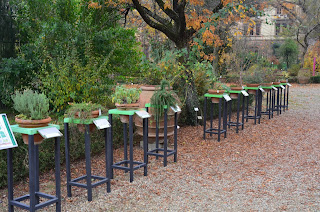Last Saturday, we visited the Botanical Garden - il giardino dei simplici. The simplici, simples in English (or in French for that matter), are the medicinal plants that were considered effective on their own. They do not have to be mixed with others to form a compound. The use of that name for the garden and the reference to medicinal plants suggest how old this garden is. In fact it was established on December 1st, 1545.
Nowadays there is still a large section given over to medicinal and culinary plants, but ornamental plants are also prominent. There were not many blooms at this time of the year. The most prominent were some paperwhite daffodils, the kind we force indoor, but which here have been naturalized in the garden.
On the left are greenhouses and on the right are orangeries - the ancestors of green houses. Half the roof is glass, and there are large front windows to let in light.
At one end of the orangeries are plants that have been taken in for the winter to be kept above freezing.
The other end is kept warmer for tropical plants like this hibiscus (Malvaviscus arboreus) from Central America and the south-eastern U.S.
Some of the herbs are grown in pots raised on wooden supports, so you do not have to bend down in order to look at them closely or smell them.
Some of the large pots are draped with roses, which must be quite attractive in summer. It is something we could try, but we would, of course, have to take the pots in to make sure they do not freeze in winter.
A few roses were still blooming, including this variety called "Pompom de Paris".
The pots on each side of this alley hold rhododendrons. One was in bloom.
There are lots of cold frames where all the succulents and cacti have been stored to protect them over the winter.
One of the most interesting things was in the greenhouse. Some of the perfumes that come from plants were provided, together with the source plant or part of it. It was most interesting to see the plant or its part and smell its essence. There were patchouli, myrrh, levant storax (a gum used in perfume), jojoba and others I have forgotten.
The most impressive plant was unfortunately not identified. It was a climber covered in December with orange daisies as if it had been July.
Nowadays there is still a large section given over to medicinal and culinary plants, but ornamental plants are also prominent. There were not many blooms at this time of the year. The most prominent were some paperwhite daffodils, the kind we force indoor, but which here have been naturalized in the garden.
On the left are greenhouses and on the right are orangeries - the ancestors of green houses. Half the roof is glass, and there are large front windows to let in light.
At one end of the orangeries are plants that have been taken in for the winter to be kept above freezing.
The other end is kept warmer for tropical plants like this hibiscus (Malvaviscus arboreus) from Central America and the south-eastern U.S.
Some of the large pots are draped with roses, which must be quite attractive in summer. It is something we could try, but we would, of course, have to take the pots in to make sure they do not freeze in winter.
A few roses were still blooming, including this variety called "Pompom de Paris".
The pots on each side of this alley hold rhododendrons. One was in bloom.
There are lots of cold frames where all the succulents and cacti have been stored to protect them over the winter.
One of the most interesting things was in the greenhouse. Some of the perfumes that come from plants were provided, together with the source plant or part of it. It was most interesting to see the plant or its part and smell its essence. There were patchouli, myrrh, levant storax (a gum used in perfume), jojoba and others I have forgotten.
The most impressive plant was unfortunately not identified. It was a climber covered in December with orange daisies as if it had been July.











No comments:
Post a Comment
Thank you for leaving a comment